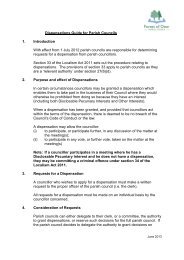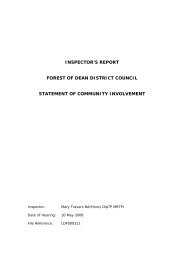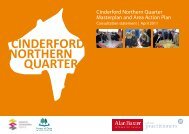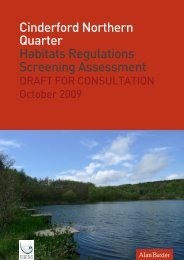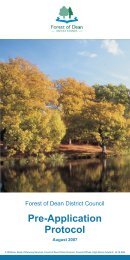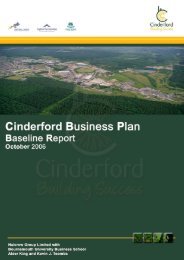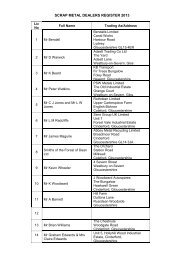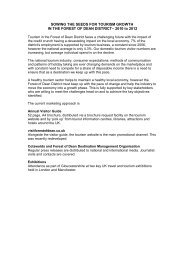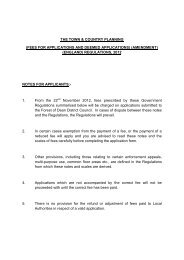4.0 Cinderford - Forest of Dean District Council
4.0 Cinderford - Forest of Dean District Council
4.0 Cinderford - Forest of Dean District Council
- No tags were found...
Create successful ePaper yourself
Turn your PDF publications into a flip-book with our unique Google optimized e-Paper software.
<strong>4.0</strong> <strong>Cinderford</strong>
<strong>4.0</strong> <strong>Cinderford</strong>4.1 IntroductionHistorically, <strong>Cinderford</strong> developed very rapidly in the mid 19th centuryaround <strong>Cinderford</strong> Bridge, with urbanisation due to the influx <strong>of</strong> workersrequired for increasingly commercialised mining. The development <strong>of</strong><strong>Cinderford</strong> echoes the earlier history <strong>of</strong> encroachment settlements in the<strong>Forest</strong>, in that it is essentially unplanned and ad-hoc in nature. By the late19th century a town centre had developed to the north <strong>of</strong> the bridge, withschools, shops, civic buildings and churches. In the 20th century publictransport came to the town with a train and tram station.Fig. 4.1.1 Statutory <strong>Forest</strong> boundary and siteIn the early to mid 20th century the commercial industry declined dueto depletion <strong>of</strong> iron and coal and the flooding <strong>of</strong> mine shafts, <strong>of</strong>tencaused by existing workings. By the 1960s all the mines in and around<strong>Cinderford</strong> had closed, along with the town’s passenger rail station. Thetown faced a major challenge in finding new and diversified employmentopportunities.<strong>4.0</strong> <strong>Cinderford</strong>Today, <strong>Cinderford</strong> has a population <strong>of</strong> approximately 8,000 people, witha high proportion <strong>of</strong> children. A high proportion <strong>of</strong> people commute out<strong>of</strong> the town, especially those in pr<strong>of</strong>essional jobs. The town has lowerthan average owner occupation percentage and a high proportion <strong>of</strong>affordable housing. Most <strong>of</strong> the town lies within the Statutory <strong>Forest</strong>Boundary.<strong>Cinderford</strong> has a programme <strong>of</strong> regeneration, being brought togetherunder the <strong>Cinderford</strong> Regeneration Board (CRB) and being led by the<strong>Forest</strong> <strong>of</strong> <strong>Dean</strong> <strong>District</strong> <strong>Council</strong> (FoDDC), Gloucester County <strong>Council</strong>,SWRDA, the <strong>Forest</strong>ry Comission and the Homes and Communities Agency(HCA). The Local Plan identifies proposals across the town. The CRB hascommissioned a Business Plan, that has some overlap with elements <strong>of</strong>the Local Plan, but specifically develops the regeneration aspects for thetown.This section <strong>of</strong> the baseline report covers the following subjects on the<strong>Cinderford</strong> scale:• <strong>Forest</strong> <strong>of</strong> <strong>Dean</strong> LocalDevelopment Scheme• <strong>Forest</strong> <strong>of</strong> <strong>Dean</strong> <strong>District</strong><strong>Council</strong> planning context• <strong>Cinderford</strong> Business Plan• Local property review• Socio-economic context• Historical development <strong>of</strong><strong>Cinderford</strong>• Urban morphology andtownscape• Building typologies• Landscape• Land use. heritage andfacilities• Movement• Land-use• Urban morphology andTownscape• Building typologiesKeyArea within theStatutory <strong>Forest</strong>boundarySite30 <strong>Cinderford</strong> Northern Quarter Baseline Report / April 2009Alan Baxter
4.2 Local Development SchemeRelationship with Core StrategyRelationship with previous Business Plan study<strong>4.0</strong> <strong>Cinderford</strong>The <strong>Forest</strong> <strong>of</strong> <strong>Dean</strong> <strong>District</strong> <strong>Council</strong> (FoDDC) Local DevelopmentScheme (LDS) (June 2007) originally indicated that the Core Strategyand <strong>Cinderford</strong> AAP would have very similar timescales withsimultaneous submission, and a subsequent one month lag throughthe Examination process between Core Strategy and AAP. Feedbackfrom the Planning Inspectorate at the time indicated that there weresome concerns about submitting both DPDs at the same time. Thefeedback stated that in exceptional circumstances (which wouldneed to be agreed between GOSW and FoDDC) and where “there is aneed to press on”, the Inspector would be prepared to start with thesubsequent DPDs before the Core Strategy report is complete, evenin draft form. This could be four weeks after the hearing sessions intothe Core Strategy have closed.It should be noted that Government guidance states that in generalno Development Plan Documents (e.g. the AAP) should come forwardin advance <strong>of</strong> the Core Strategy (the <strong>District</strong> wide strategy whichoutlines the overarching spatial strategy and framework for, amongstother things, land use change).The AAP process will therefore need to be managed to ensure thatthe AAP does not overtake the Core Strategy. It will need to ensurethat the Core Strategy is fully resolved in terms <strong>of</strong> the broad spatialstrategy for <strong>Cinderford</strong> and any contentious issues relating to theNorthern Quarter are incorporated within the AAP rather than theCore Strategy. Potential issues will be consulted upon and testedas part <strong>of</strong> the preferred options process for the AAP and resolvedin broad terms <strong>of</strong> environmental / sustainability and during themasterplanning phase.The consultant team attended a meeting with representatives <strong>of</strong>the Government Office in February 2009. It was confirmed that thePlanning Inspectorate has recently indicated that the Examinationprocess in the region is estimated to be six or seven months ratherthan 12 months. In this context, GOSW feel comfortable with theproposed degree <strong>of</strong> overlap in the Examination process between CoreStrategy and AAP. GOSW stated that they are comfortable in principlewith a February 2010 submission as this will enable any amendmentsto be made to the AAP following initial informal feedback from theInspector in relation to the Core Strategy.The <strong>Cinderford</strong> Business Plan was commissioned by the <strong>Cinderford</strong>Regeneration Board in April 2006 in order to plan out and driveforward the regeneration <strong>of</strong> <strong>Cinderford</strong> over a ten year period. The<strong>Cinderford</strong> Business Plan Issues and Options Report was published inFebruary 2007 and contains issues and four different spatial optionsfor <strong>Cinderford</strong>. These were consulted on in detail and comprise theIssues and Options stage <strong>of</strong> this AAP process.In order to take these issues and options through to PreferredOption stage as part <strong>of</strong> the AAP production, the Business Planissues and spatial options will be reviewed and assessed througha masterplanning process. From this, strategic policies and designguidance will be drawn up which can be adopted in the form <strong>of</strong> astatutory AAP. The AAP will also articulate the planning rationalebehind each <strong>of</strong> the Business Plan options, and demonstrate robustgrounds for choosing the preferred option, informed by an up-todatereview <strong>of</strong> planning policy, the local evidence base and Issues andOptions consultation feedback.Retail capacity study and town centre contextThe <strong>Forest</strong> <strong>of</strong> <strong>Dean</strong> <strong>District</strong> Retail Study (October 2008) provides anup-to-date review <strong>of</strong> national, regional and local retail policies andtrends. In view <strong>of</strong> these, the study evaluates retail provision within the<strong>Forest</strong> <strong>of</strong> <strong>Dean</strong> in order to make a series <strong>of</strong> policy recommendations.<strong>Cinderford</strong> is the second largest town centre in the district in terms <strong>of</strong>retail and commercial unit numbers and is identified in the GloucesterLocal Plan as a principal retail centre. The settlement experiencessignificant leakage <strong>of</strong> comparison expenditure to nearby regionalshopping centres Bristol, Gloucester and Cheltenham and theproximity <strong>of</strong> the <strong>Forest</strong> <strong>of</strong> <strong>Dean</strong> market towns (Lydney, <strong>Cinderford</strong> andColeford) to each other creates local competition, which has limitedthe level <strong>of</strong> retail expansion experienced by them. Alongside goodaccess to nearby regional shopping centres, comparison expenditureleakage is also attributed to a shortage <strong>of</strong> car parking, poor quality<strong>of</strong> existing parking capacity and poor visual appearance <strong>of</strong> the towncentre. Within the town centre, comparison uses are below thenational average and vacancy rates are currently high.In view <strong>of</strong> this, the retail study recommends provision <strong>of</strong> higher levels<strong>of</strong> comparison floorspace (quantitative need <strong>of</strong> 1,150sq m net by 2012,rising to 2,290sq m net by 2021), provided within the town centreboundary. The study also sees a clear justification for a new largefoodstore which can help retain greater levels <strong>of</strong> main food shoppingtrips, taking into consideration its impact on the financial performance<strong>of</strong> surrounding settlements, particularly Coleford.In support <strong>of</strong> this, the strategy supports enhancements to <strong>Cinderford</strong>which will make it more attractive to visitors, particularly regardingpedestrian movement and access to parking provision, and measuresto reduce vacancies. A study has recently been undertaken toexamine opportunities to improve the public realm in <strong>Cinderford</strong>which would play a key role in enhancing the retail experience.Overall, the study identifies clear potential and justification for arevised market share approach to convenience retailing in <strong>Cinderford</strong>.Assuming a 100% retention <strong>of</strong> all convenience shopping from<strong>Cinderford</strong> and there being no change in the level <strong>of</strong> inflow fromwithin or outside <strong>of</strong> the study area, then there will be capacity for anadditional 1,070sq m net by 2012, rising to 1,260sq m net by 2021.This approach is in line with policy options for the other key towns (i.e.self containment), although there is potential for this capacity levelto increase where convenience expenditure from other parts <strong>of</strong> thestudy area is utilised to support a new store.The Retail Capacity Study states that “...the rugby club site is the mostappropriate for large scale retail provision, in addition to smaller siteselsewhere in the town centre which are likely to be more suitable forsmaller scale retail uses. However, in order for the rugby club site t<strong>of</strong>unction as a true extension to the core shopping area there will need tobe a reasonable prospect <strong>of</strong> pedestrian linkages between the store andcentre.”32 <strong>Cinderford</strong> Northern Quarter Baseline Report / April 2009Alan Baxter
4.3 <strong>Forest</strong> <strong>of</strong> <strong>Dean</strong> <strong>District</strong> <strong>Council</strong> planning context<strong>Forest</strong> <strong>of</strong> <strong>Dean</strong> <strong>District</strong> <strong>Council</strong> planning contextThe <strong>Forest</strong> <strong>of</strong> <strong>Dean</strong> <strong>District</strong> <strong>Council</strong> Core Strategy (2008) <strong>of</strong>fers aspatial vision for the district, with strategies for each <strong>of</strong> the <strong>Forest</strong> <strong>of</strong><strong>Dean</strong> settlements. <strong>Cinderford</strong>’s range <strong>of</strong> employment uses are to beincreased to widen the town’s service base and address educationalachievement and deprivation. The Northern Quarter is consideredthe suitable location for a mixed use scheme which will help meetemployment and residential needs. Crucially, <strong>Cinderford</strong>’s excellentphysical setting is seen as pivotal to the success <strong>of</strong> the scheme, anddevelopment will therefore need to be <strong>of</strong> the highest quality.The strategy provides for 700 dwellings up to the year 2026, 40% tobe affordable and 60% on previously developed land. It also providesfor development <strong>of</strong> 26ha employment land, including sites foreducational use, a hotel, a biomass plant and <strong>of</strong>fice accommodationas part <strong>of</strong> mixed use development at Steam Mills.The <strong>Forest</strong> <strong>of</strong> <strong>Dean</strong> Local Plan Review (2005) contains a set <strong>of</strong> districtwideand settlement-focused policies. This will be superseded oncethe Core Strategy is adopted. Of the <strong>Forest</strong> <strong>of</strong> <strong>Dean</strong> settlements,<strong>Cinderford</strong> has the largest employment base, mostly focused onthe <strong>Forest</strong> <strong>of</strong> Vale Industrial Estate, but the settlement is also ingreatest need <strong>of</strong> new employment and revitalisation. The localplan recommends augmenting <strong>Cinderford</strong>’s employment basethrough redevelopment <strong>of</strong> brownfield sites, accompanied by newhousing stock, including affordable housing, and investment intoinfrastructure and community facilities.The local plan acknowledges that the surrounding <strong>Forest</strong> <strong>of</strong> <strong>Dean</strong>restricts development opportunities on the one hand, but gives thesettlement enormous potential as an attractive location on the other.The plan also identifies industrial archaeological potential in<strong>Cinderford</strong>, and requires that development proposals on siteswhere archaeological interest may be affected should be subject toarchaeological assessment.• <strong>Cinderford</strong> 3 - 8.7ha for B1, B2 and B8 employment use.Proposals to contribute to the proposed western access roadto <strong>Cinderford</strong> and to access by walking, cycling and publictransport.• <strong>Cinderford</strong> 5 - 6ha land at Newtown for 70 dwellings and 3.4haemployment land for B1 and B2, plus contributions to newsustainable transport links, affordable housing, educational andyouth provision, landscaping and the <strong>Forest</strong> Vale spine roadextension and environmental mitigation measures.• <strong>Cinderford</strong> 12 - Safeguarding <strong>of</strong> land for Western Access routewith appropriate mitigation and compensatory provision toaddress environmental impacts arising from the development.• <strong>Cinderford</strong> 13 - Safeguarding <strong>of</strong> land for construction<strong>of</strong> <strong>Forest</strong> Vale spine road extension to Steam Mills withappropriate mitigation and compensatory provision to addressenvironmental impacts arising from the development.• <strong>Cinderford</strong> 14 - Land comprising the <strong>Cinderford</strong> Linear Parkwill be further developed for leisure and recreational use withadditional land to be allocated as an extension to the Linear Parkat Nailbridge.• <strong>Cinderford</strong> 15 - 11.3ha surrounding the Steam Mills Lake forleisure and recreation. Contributions are expected towards theconstruction <strong>of</strong> the Western access road to <strong>Cinderford</strong> and toenvironmental mitigation measures.Fig. 4.3.1 Local Plan land allocations(R) F.CINDERFORD 5.R) F.CINDERFORD 3.(R) F.CINDERFORD 15.(R) F.CINDERFORD 12.(R) F.CINDERFORD 14.(R) F. CINDERFORD 6.(R) F. CINDERFORD 10.(R) F. CINDERFORD 1.(R) F.CINDERFORD 9.(R) F.CINDERFORD 13.(R) F. CINDERFORD 2(R) F.SEE INCINDERFOR<strong>4.0</strong> <strong>Cinderford</strong>Within <strong>Cinderford</strong>, the plan provides for 26ha for employment use andfor 585 dwellings, with land allocations for the Northern Quarter asfollows:• <strong>Cinderford</strong> 2 - 3 hectares <strong>of</strong> land at Newtown allocated for B1,B2 and B8 employment use (with only B1 adjoining existingresidential areas). Proposals to contribute to spine roadextension, safe and convenient pedestrian and cycling links andprovision / enhancement <strong>of</strong> bus services.Alan Baxter<strong>Cinderford</strong> Northern Quarter Baseline Report / April 200933
4.4 <strong>Cinderford</strong> Business Plan<strong>4.0</strong> <strong>Cinderford</strong>OverviewIn 2007, a client team led by <strong>Cinderford</strong> Regeneration Board (CRB)and also including <strong>Forest</strong> <strong>of</strong> <strong>Dean</strong> <strong>District</strong> <strong>Council</strong> (FoDDC), EnglishPartnerships (EP) and South West <strong>of</strong> England Regional DevelopmentAgency (SWRDA) prepared the <strong>Cinderford</strong> Business Plan. In additionto setting out key strategies and project-based interventions, theBusiness Plan also forms part <strong>of</strong> the evidence base for the Area ActionPlan. The content in the final Business Plan document (December2007) is articulated as a preferred option and is supported in thecontext <strong>of</strong> a thorough analysis <strong>of</strong> issues and options as set out in theBusiness Plan Issues and Options Report (February 2007).The Business Plan draws on a detailed Baseline Report which identifiesa wide range <strong>of</strong> statistics and information about <strong>Cinderford</strong> andoutlines the key opportunities and constraints which will shape thefuture development <strong>of</strong> the area. The Baseline Report considers thefollowing topics:• Strategic and local policy framework;• Economic baseline;• Social and community facilities baseline;• Market appraisal;• Transport infrastructure and movement;• Landscape character and ecology; and• Townscape and built heritage.The Baseline Report informed the development <strong>of</strong> an Issues andOptions report, published in February 2007. The purpose <strong>of</strong> thisdocument was to:• Explore the possible actions, projects and initiatives that could betaken forward to contribute towards <strong>Cinderford</strong>’s regeneration;• Consider the availability <strong>of</strong> land on which new facilities couldbe built – it concluded that the Northern Quarter and the towncentre were the two key sites that would play the most criticalrole in <strong>Cinderford</strong>’s future;• Put forward a range <strong>of</strong> options for how the Northern Quartercould be developed - either with a recreation, residential,employment/learning, or mixed use focus; and• Identify options for the redevelopment <strong>of</strong> the town centre, basedon various extents <strong>of</strong> change.In line with guidance in PPS12, the process <strong>of</strong> generating andreviewing issues and options included significant ongoingconsultation and participation with the community and stakeholders.The Business Plan summarises the consultation as follows:• Both the full Issues and Options report and a short ExecutiveSummary were made available on the project website www.cinderford2016.net. Copies <strong>of</strong> the Executive Summary were alsomade available in a range <strong>of</strong> public buildings. Stakeholders wereinformed about this phase <strong>of</strong> the consultation by letter.• Comments were also invited via a short feedback form. 96completed feedback forms were returned to the <strong>District</strong> <strong>Council</strong>.In addition a number <strong>of</strong> letters were received.• The Issues and Options Report was the subject <strong>of</strong> discussionsand meetings between individuals, local businesses and <strong>of</strong>ficersfrom partner organisations, and therefore a depth <strong>of</strong> qualitativefeedback was obtained.• The <strong>Cinderford</strong> Consultative Group has been involved incommenting on the emerging Business Plan throughout theprocess.• <strong>Cinderford</strong> Regeneration Board received regular presentationson the emerging Business Plan which also included a number <strong>of</strong>interactive workshops.Following the completion <strong>of</strong> the issues and options stage, the finalreport <strong>of</strong> the Business Plan was completed in December 2007. Thepurpose <strong>of</strong> this section is to review the following information from theBusiness Plan:• Strategic objectives – a summary <strong>of</strong> aims and objectives whichunderpin the Business plan;• Key issues and opportunities identified in the evidence base;• Northern Quarter – summary <strong>of</strong> the site context;• Summary <strong>of</strong> options – review <strong>of</strong> the four options which weregenerated during the course <strong>of</strong> the project; and• Preferred option summary – the core components <strong>of</strong> thepreferred option.34 <strong>Cinderford</strong> Northern Quarter Baseline Report / April 2009Alan Baxter
4.4 <strong>Cinderford</strong> Business PlanStrategic objectivesThe <strong>Cinderford</strong> Business Plan sets out a series <strong>of</strong> strategic objectiveswhich emerged from public consultation at the early stages <strong>of</strong>Business Plan preparation and consultation stakeholders and fundingbodies.Chapter 3 <strong>of</strong> the Business Plan final report sets out a detailed andcomprehensive narrative for each <strong>of</strong> the strategic objective. Eachobjective is amplified with a statement <strong>of</strong> aims and is justified in aconcise statement <strong>of</strong> rationale which draws upon the evidence baseand policy requirements and strategic policies or initiatives. It islikely that the Preferred Options report and AAP will draw on theseobjectives and supporting statements in detail as they have a clearrationale in relation to evidence based research and consultation, andare coherent in planning terms. A brief summary <strong>of</strong> each strategicobjective is provided below.• Code for Sustainable Homes – supporting higher standards<strong>of</strong> sustainability in relation to the building and operation <strong>of</strong>homes (and where appropriate employment and communityuses) to be achieved through greater energy efficiency, waterefficiency, surface water management, site waste management,household waste management and use <strong>of</strong> materials. Meetingrecommended standards in relation to Lifetime Homes,additional sound insulation, private external space, higherdaylighting standards and improved security will also berequired.• South West Regional Economic Strategy 2006-15 – promoting areduced environmental footprint and a low carbon approach toeconomic development at a regional scale.Housing allocations• Regional policy constrains supply <strong>of</strong> housing to that allocatedin the current Local Plan over the period to 2026. There is anapparent need to speed up the delivery <strong>of</strong> allocated sites asrelocation and infrastructure issues has caused inertia in thedevelopment <strong>of</strong> peripheral sites.• The <strong>Council</strong> has confirmed that it would be acceptable toredistribute district housing targets to enable an additional 150dwellings to be provided in <strong>Cinderford</strong> beyond 2011.• There is a need for allocation <strong>of</strong> land for housing givingconsideration to housing need, RSS requirements, the need formixed and sustainable communities, maximisation <strong>of</strong> affordablehousing provision and best use <strong>of</strong> previously developed sites.Strategic objective: A model <strong>of</strong> sustainable new developmentAimTo promote <strong>Cinderford</strong> as a regional model <strong>of</strong> sustainable newdevelopment and management, and reduce the town’s “carbonfootprint”.Rationale and evidence base:• Policy agenda at all scales to achieve sustainable use <strong>of</strong>resources.• To prioritise sustainability and differentiate <strong>Cinderford</strong> from othertowns.• Key message is that eco-principles are increasingly underpinningmany funding criteria and therefore the very highest standardsshould be met to secure funding.• Sustainability concepts received widespread public supportthrough consultation.Strategic objective: A desirable and affordable place to liveAimTo provide a mix <strong>of</strong> new housing types, deliver more affordablehousing for first time buyers and low income families and make betteruse <strong>of</strong> the existing housing stock.Rationale and evidence base:Housing need and demand• Growing housing need within the town and district - <strong>Cinderford</strong>has a lower level <strong>of</strong> owner occupation than the district andregional levels. Rate <strong>of</strong> increase <strong>of</strong> prices is much higher for lowerend properties (flats, maisonettes and terraces) than higher-endproperties. Wage increases in the district are not keeping pacewith regional and national trends.• Strong housing demand – local demand for modern twobedroomaccommodation and shared ownership housing.Limited demand for higher end properties.Balancing housing and employment uses• Careful consideration needs to be given to the balance <strong>of</strong>housing and employment in the context <strong>of</strong> creating a balancedcommunity.• Based on 2001 census figures <strong>Cinderford</strong> has a population <strong>of</strong>8,120 <strong>of</strong> which 4,862 are <strong>of</strong> working age. However, <strong>Cinderford</strong>only has 4,186 jobs which means that a significant proportion <strong>of</strong>the working age population must commute out <strong>of</strong> <strong>Cinderford</strong> forwork. The Business Plan recommends that one job be providedfor each house built.• To safeguard the long-term future <strong>of</strong> the town there is a need toensure that sites come forward for housing, but that these arecomplementary to necessary employment growth in the town.<strong>4.0</strong> <strong>Cinderford</strong>Key policy references• PPS1: Delivering Sustainable Development (2005) - socialinclusion, protection and enhancement <strong>of</strong> the environment,prudent use <strong>of</strong> resources and good design.• Housing Green Paper (2007) – commitment to achievingsustainability in new homes and achieving zero carbondevelopment in homes with interim reduction targets.• Population size has increased by 6% between 1991 and 2001with growth in 35-44 and 45-49 age bands but the younger agebands have experienced declining or only marginal populationincreases. Potential “pricing out” <strong>of</strong> younger groups from thehousing market and need for entry-level housing.Alan Baxter<strong>Cinderford</strong> Northern Quarter Baseline Report / April 200935
4.4 <strong>Cinderford</strong> Business PlanStrategic objective: An exciting place to work and do businessAimTo stimulate economic development which raises the skills level <strong>of</strong> thelocal workforce, providing higher skilled and higher paid employmentand opportunities for self employment.a mismatch between supply and demand with sites being toosmall and inflexible to meet needs <strong>of</strong> prospective businesses.• In addition to enhancing the quality and quantity <strong>of</strong> land supply,there is a need to rejuvenate and intensify existing employmentsites, particularly on industrial estates.• The Business Plan identifies strong community support for a new“flagship” community facility and makes the case for a holisticapproach to regeneration making a strong case for the educationand health benefits <strong>of</strong>fered by out-<strong>of</strong>-hours and informalcommunity provision.<strong>4.0</strong> <strong>Cinderford</strong>Rationale and evidence base:• <strong>Cinderford</strong> has a relatively poor skills base with higher thanaverage proportion <strong>of</strong> local working age population having noqualification.• The area has a high concentration in manufacturing andemployment with lower proportions in tertiary employmentsectors. There is a need to maintain the traditionalmanufacturing strengths and skills as well as expanding in areassuch as <strong>of</strong>fice employment.• Commuting patterns are complex with a significant element <strong>of</strong>out-commuting and in-commuting (58% <strong>of</strong> the workforce livein <strong>Cinderford</strong> or the Area <strong>of</strong> Influence). Just under 4,300 peoplecommute out <strong>of</strong> the Core Area and Area <strong>of</strong> Influence for workand 4,000 commute in.• There is an acknowledged shortage <strong>of</strong> available land as identifiedin the emerging Core Strategy and the Employment and TourismIssues and Options Consultation paper (2006). There is a needfor the AAP to identify sufficient supply <strong>of</strong> sites to meet localrequirements, make best use <strong>of</strong> previously developed land,make best use <strong>of</strong> infrastructure provision and provide land inproportion with housing provision.Strategic objective: An accessible place which is well connectedAimTo provide better road, pedestrian and cycle access both to, andwithin, <strong>Cinderford</strong>.Rationale and evidence base:• There is a perception that <strong>Cinderford</strong> is remote, particularly inrelation to potential businesses who view travel time from M5as a constraint. Poor accessibility from the A4136 to the northis considered to be a major constraint to economic prosperityand constrains development sites at Steam Mills. Provision <strong>of</strong> anew link road on an alternative alignment has been identified asa way to improve perceptions <strong>of</strong> accessibility and to unlock thepotential <strong>of</strong> development sites.Strategic objective: A more active community with better facilitiesAimTo provide significantly improved community facilities, to serve boththe local population and also a wider catchment area.Strategic objective: An attractive, green and sustainableenvironmentAimTo bring the quality <strong>of</strong> the <strong>Forest</strong> and environment surrounding<strong>Cinderford</strong> into the town itself and ensure that any new developmentrespects its forest setting.Rationale and evidence base:• The physical links between the town and the <strong>Forest</strong> are weakand regeneration proposals should place distinctive naturalassets and features at the heart <strong>of</strong> proposals. The Business Planemphasises the importance <strong>of</strong> an appealing environmentalsetting in attracting new businesses and securing inwardinvestment.Strategic objective: A fun and imaginative place to visitAimTo put <strong>Cinderford</strong> ‘on the map’ and ensure that more people who visitthe <strong>Forest</strong> come into <strong>Cinderford</strong> itself.• The Business Plan confirms that there is a limited supply <strong>of</strong> landfor employment and there is a need to diversify the employmentto generate a more sustainable and balanced town. Quality <strong>of</strong>employment is regarded as a higher priority than quantity <strong>of</strong>development.• Market demand analysis undertaken as part <strong>of</strong> the Business Planprocess identified that <strong>of</strong>fice development could be attractedif high quality sites are provided in an attractive setting withgood access. In relation to small industrial units, small firmscould be encouraged to locate in <strong>Cinderford</strong> if appropriatesites and premises are provided. Analysis <strong>of</strong> available premisesand enquiries for general industrial sites indicates that there isRationale and evidence base:• Work associated with the SRB6 Regeneration Programme andmore recent consultation has confirmed that there is strongpublic support for a range <strong>of</strong> community facilities to be providedin <strong>Cinderford</strong>. These range from youth facilities such as an indoorskate park facility to leisure pools and spa facilities. There is alsoa demand for facilities and community halls from existing clubsand groups in the area. There is also major shortfall <strong>of</strong> playspaceand sports pitches in the town.Rationale and evidence base:• The <strong>Forest</strong> <strong>of</strong> <strong>Dean</strong> is recognised as a successful and populartourist and visitor destination but <strong>Cinderford</strong> fails to capture thebenefits <strong>of</strong> this potential market. A wide range <strong>of</strong> interventionsare identified which would benefit both visitors and residents.These include retail, food and leisure enhancements,provision <strong>of</strong> improved sports and community facilities,greater accommodation <strong>of</strong>fer including a new hotel, heritageinterpretation facilities and exemplar buildings and features froma sustainability perspective.36 <strong>Cinderford</strong> Northern Quarter Baseline Report / April 2009Alan Baxter
4.4 <strong>Cinderford</strong> Business PlanStrategic objective: A supportive and inclusive place to learnAimPromote lifelong learning to deliver sustainable economicdevelopment, social progress and health and well-being.Rationale and evidence base:• The Index <strong>of</strong> Multiple Deprivation illustrates that parts <strong>of</strong>Cindeford rank within the top 10% <strong>of</strong> most deprived areas in thecountry for education skills and training.• There is clearly a need to raise skills levels in order to open up awider range <strong>of</strong> employment opportunities for individuals andprovide a skills base which will support the attraction <strong>of</strong> businessinvestment into <strong>Cinderford</strong>.• The key opportunity identified relates to the provision <strong>of</strong> a newcampus for Royal <strong>Forest</strong> <strong>of</strong> <strong>Dean</strong> College. The Business Planalso emphasises <strong>Cinderford</strong>’s strength in relation to the creativesector which is also a priority identified in the South West RDA’sRegional Economic Strategy and Corporate Plan.Key issues and opportunities identified in the evidencebaseThe Business Plan identifies a series <strong>of</strong> major opportunities basedon a review <strong>of</strong> the evidence base and are summarised as follows. Itis important to ensure that the Northern Quarter site is not treatedin isolation and that proposals for the AAP area are set within anunderstanding <strong>of</strong> social, economic and environmental dynamics atlocal and sub-regional scales.Opportunities <strong>of</strong> greatest relevance to the Northern Quarter aremarked with an asterisk.New <strong>of</strong>fice development *Objective: To help diversify the local economy.Location: A high quality new development, potentially set aroundSteam Mills Lake.New industrial development *Objective: To respond to strong demand for industrial basedemployment.Location: Use should be made <strong>of</strong> space on the existing industrialestates, subsequently new sites at Steam Mills, Newtown or NorthernUnited could be considered.New ground for football club *Objective: To identify a site for <strong>Cinderford</strong> Football Club which willenable provision <strong>of</strong> improved facilities and access.Location: Steam Mills Lake/Hawkwell Enclosure area, subject toecological and landscape constraints and reasonable sharing <strong>of</strong>facilities.New biomass facility *Objective: To generate power in a green, sustainable way (by utilisingforest waste products).Improvements to the Linear Park *Objective: To harness the potential <strong>of</strong> the park for leisure andconservation.Location: The Linear Park south <strong>of</strong> the sewage treatment works,subject to a detailed management plan, possibly creating a formalpark at its southern end.New mixed tenure housing *Objective: To enable young people to get on the housing ladder andto provide more top-level housing.Location: A mix <strong>of</strong> housing types, to include affordable housing, notonly on allocated sites, but also at Steam Mills and St Whites and aspart <strong>of</strong> mixed use schemes elsewhere.New road link to A4136 *Objective: To improve access to <strong>Cinderford</strong> from the north andimprove perceptions <strong>of</strong> accessibility to encourage inward investment.Location: Aspiration to extend the Valley Road spine road byproviding a new tree lined avenue, either between the A4136 andValley Road or between the A4151 and Valley Road. This would createan attractive new entrance to the town.Greening <strong>of</strong> key transport routes *Objective: To improve the image <strong>of</strong> <strong>Cinderford</strong> in relation toenhancing the experience <strong>of</strong> roads in <strong>Cinderford</strong>.Location: Key links from A48 and A4136, to enhance wildlife links andbring the <strong>Forest</strong> to the town.New multi-use activity centre *Objective: To provide indoor leisure facilities, such as skate park,climbing wall and leisure pool, to <strong>of</strong>fer diversion and interest forresidents and wet weather facilities for visitors.Location: Possibly the Steam Mills area or the rugby training ground.<strong>4.0</strong> <strong>Cinderford</strong>Location: There is interest from the private sector in developing a siteeither at Northern United or within the <strong>Forest</strong> Vale Industrial Estate.Alan Baxter<strong>Cinderford</strong> Northern Quarter Baseline Report / April 200937
4.4 <strong>Cinderford</strong> Business PlanNew campus for Royal <strong>Forest</strong> <strong>of</strong> <strong>Dean</strong> College *Objective: To improve education and skills in <strong>Cinderford</strong> and toprovide new community facilities and confidence.New tourist attraction at Drybrook QuarryObjective: To provide new tourist facilities <strong>of</strong> real interest in the east<strong>of</strong> the <strong>Forest</strong>, and this site could <strong>of</strong>fer considerable potential.Redevelopment in the town centreObjective: To provide a layout able to attract retail and leisureinvestment and make the centre more attractive and safer.<strong>4.0</strong> <strong>Cinderford</strong>Location: Subject to the findings <strong>of</strong> a separate study - Steam MillsLake.An Environment Centre *Objective: To provide an educational resource based oninterpretation <strong>of</strong> the natural environment.Location: Potentially within close proximity <strong>of</strong> the Linear Park or theNatural England grassland site.A ‘Gateway’ Centre *Objective: To act as a focus for tourist information. Potentially to linkwith/double up as an Environment Centre.Location: At a prominent location on the approach to <strong>Cinderford</strong>.Public transport provisionObjective: To improve public transport connections to outlyingvillages and connections to major towns particularly at evenings andweekends.Location: All new developments proposed will only proceed if apublic transport plan can be implemented.New retail developmentObjective: To improve the range <strong>of</strong> shops, and prevent ‘leakage’ <strong>of</strong>shopping trips to other towns.Location: Drybrook Quarry, subject to landowners’ support andresults <strong>of</strong> costed feasibility study.Improved management <strong>of</strong> parking provisionObjective: To improve the perception <strong>of</strong> inadequate parking andsigning.Location: Existing car parks, in particular Heywood Road. Possible newparking in association with new town centre development. Improvemanagement and provide better footways to car parks.Greening <strong>of</strong> <strong>Forest</strong> Vale Industrial EstateObjective: To create a higher quality environment and attract newemployers, using new trees, shrubs, lighting and public art.Location: Throughout the industrial estate, focusing on the entrancesand key transport routes.Intensification <strong>of</strong> <strong>Forest</strong> Vale Industrial EstateObjective: To create sites for new employers and be able to cater forexpansion needs <strong>of</strong> existing employers.Location: Unused or inefficiently used sites throughout the estate, butespecially near Broadmoor Brickworks and the cricket ground.Improved traffic managementObjective: To reduce the impact <strong>of</strong> traffic on the town centre.Location: A number <strong>of</strong> key sites for potentially significantredevelopment have been identified, these include land between theTriangle and the Coop and land between the Westgate Store and theMiners Welfare Hall.Intensified residential uses in town centreObjective: To introduce new housing in the town centre to make itmore vibrant and make better use <strong>of</strong> space above shops.Location: Conversion/upgrading <strong>of</strong> space above shops andredevelopment <strong>of</strong> shops outside core retail area.Relocation <strong>of</strong> the abattoirObjective: To promote re-location <strong>of</strong> the existing site which is closeto residential development to an alternative site in <strong>Cinderford</strong> witha view to retaining jobs locally, and enabling the existing site to beredeveloped for housing.Location: A large site, away from housing with good road connectionsin line with the emerging development concept for the town as awhole.Location: In the town centre, potentially linked to the proposed Tescostore and to car parks.New leisure facilities such as cafés, restaurants and barsObjective: To help make <strong>Cinderford</strong> more attractive to visitors, andprovide improved leisure facilities for residents.Location: Options include improving alternative routes such as St.Whites Road and Valley Road, improving signing to encourage heavyvehicles to access the industrial areas from the north or alternationsto traffic flow in the town centre, including the potential creation <strong>of</strong> aone-way system.Location: In the town centre.38 <strong>Cinderford</strong> Northern Quarter Baseline Report / April 2009Alan Baxter
4.5 Local property market reviewOverview Residential CommercialThe UK property market is currently experiencing a significantdownturn as a result <strong>of</strong> the credit crunch and the turmoil in globalfinancial markets. The housing market correction continues, with pricedeflation approaching 15% and significantly fewer transactions asa result <strong>of</strong> the restriction on mortgage availability. The commercialproperty market has also been severely affected, with lower demandfor commercial space and reduced availability <strong>of</strong> funding contributingto a lack <strong>of</strong> market activity. The retail and leisure markets, which rodethe early phase <strong>of</strong> the economic downturn, are now being adverselyaffected due to the reduction in consumer spending and the increasein unemployment, and are likely to experience increased stress asthe general lack <strong>of</strong> confidence, ongoing limitation on debt. Macroeconomic weakness also acts to increase caution and decrease activityin these sectors.There has been a lack <strong>of</strong> investment in the town for many years bothin terms <strong>of</strong> new development and within the current built form. Thereare limited employment opportunities in the <strong>Forest</strong>, partly due to therelatively inaccessible location compared to settlements <strong>of</strong>f the M4and M5 corridors. The lack <strong>of</strong> requirements/interest from occupiersand developers reflects limited catchment within the <strong>Forest</strong>, poorsocio-economic demographics and therefore relatively small marketvalue to be derived. Also, compared to opportunities within majorsettlements and competing towns in close proximity such as Rosson-Wye,Gloucester, Dursley, Stroud etc, the <strong>Forest</strong> <strong>of</strong> <strong>Dean</strong> is <strong>of</strong>tenoverlooked and bypassed because <strong>of</strong> the poor quality <strong>of</strong> <strong>of</strong>fer.This lack <strong>of</strong> investment also presents an opportunity for the publicsector regeneration agencies to lead the way for high qualitysustainable development the like <strong>of</strong> which has not been seen inthis area to date. This will generate confidence and a new quality <strong>of</strong>accommodation that will place <strong>Cinderford</strong> on the map, enabling it toattract occupiers, investors and new residents.Market conditions are not favourable for residential developmentat present but once the market improves the opportunity for goodquality sustainable housing is likely to be a key value driver for the site.The existing housing stock is <strong>of</strong> mixed quality and generally consists <strong>of</strong>small housing units. There have been a couple <strong>of</strong> small developmentsnear to the Steam Mills site, by Bloor Homes and Bell Homes, whichare nearing completion and demonstrate the market demand forlower-mid end market housing. There is a sizeable development <strong>of</strong>180 units proposed in <strong>Cinderford</strong> by Bloor Homes, which will be thebiggest scheme in the town, and which will potentially be nearingcompletion by the time units could be <strong>of</strong>fered for sale on Steam Mills.• Land value range - £400,000 - £600,000 per net developableclean acre <strong>of</strong> land for standard housing product (30-50 units perhectare).• Sales revenue - £165-£185 per square foot saleable grossinternal area for housing.• Sales rate – approximately 24-36 units per annum, assumingimproved market trading conditions and mixed tenure housingprovision.• Product – two and three bed traditional houses most saleable,supplemented by larger family homes and limited apartments,which would cater for the local population <strong>of</strong> first time buyers,trading up, and also new residents from outside the area.• Developers – limited national house builder interest (evenduring the peak <strong>of</strong> the property market), small local/regionaldeveloper interest and possibly one or two developing housingassociations will form the main interest for opportunities in thislocation.OfficesThere is limited <strong>of</strong>fice provision in <strong>Cinderford</strong> and that which hasbeen available has <strong>of</strong>ten been small poor quality space by modernstandards, let at very low rentals. However, Vantage Point BusinessVillage located just three miles north <strong>of</strong> <strong>Cinderford</strong> illustrates that thearea does have the potential to attract substantial occupiers: VantagePoint Business Village is a development <strong>of</strong> both <strong>of</strong>fice and industrialspace provided on the site and buildings <strong>of</strong> the former Xerox factory,with approximately 1.3 million square feet <strong>of</strong> floor space. VantagePoint has the ability to provide flexible space <strong>of</strong> varying qualities andtherefore price, at speed, as most <strong>of</strong> the space is by conversion <strong>of</strong>existing buildings. The development has recently reported a sizeableletting <strong>of</strong> 30,000 sq ft to London & General.• Rental values - £8-10 per square foot (NIA)• Yield – 8 -10% (NIY)• Land value – no direct evidence to support land value, butgeneral employment land values in the area would be in theorder <strong>of</strong> £100,000 per net developable clean acre, althoughachievable rental values suggest this would be difficult toachieve. In reality any <strong>of</strong>fice development, particularly with highdesign and sustainability standards, would need some form <strong>of</strong>gap funding.• Demand - It is unlikely that any developer would undertake anyspeculative development in the area and it would be difficult toattract national or large regional developers to the area, unlessa large pre-let is in place. There are small local developers thathave been active, but Vantage Point seems to control much<strong>of</strong> the market place and could soak up emerging demand atthe former Xerox factory. Office development is likely to beslow unless an early large anchor occupier is secured, and anyfuture supply is likely to be reliant on smaller, niche occupiersbeing attracted to the high quality environment that could beproduced, and proximity to the town centre.We are aware <strong>of</strong> a potential requirement in the <strong>Forest</strong>, which couldrequire as much as 7,500 sq m (80,730 sq ft), although it should benoted that this would be a one-<strong>of</strong>f for the <strong>Forest</strong> should it be realised.It is nonetheless further evidence <strong>of</strong> potential demand and a need forthe <strong>Forest</strong> to be able to respond to such a requirement.<strong>4.0</strong> <strong>Cinderford</strong>Alan Baxter<strong>Cinderford</strong> Northern Quarter Baseline Report / April 200939
4.5 Local property market reviewIndustrialThe majority <strong>of</strong> industrial space in <strong>Cinderford</strong> was constructed in the1970s and 1980s with supply provided in units <strong>of</strong> circa 2,000 – 5,000square feet, mirroring demand requirements. The development areaadjoins the town’s main industrial area, with <strong>Forest</strong> Vale IndustrialEstate providing a number <strong>of</strong> opportunities for a range <strong>of</strong> modernindustrial units through to open storage land. As mentioned above,Vantage Point is a significant development that <strong>of</strong>fers various gradesand sizes <strong>of</strong> industrial space. Vantage Developments also have anumber <strong>of</strong> interests in the <strong>Forest</strong> Vale Industrial Estate, and have acouple <strong>of</strong> units currently available. Also, Vantage Developmentsrecently completed and let a new build facility for CKS Ltd, associatedwith electronic recycling. However, the company recently went intoreceivership and the 56,000 sq ft unit is likely to come back on to themarket.LeisureThe leisure market covers a wide spectrum <strong>of</strong> users, from restaurantsthrough to activity centres. We have not been able to obtain anysignificant evidence in relation to activity in the leisure market in thearea. Most restaurants, pubs, hotels and guest houses in the area arerun by individuals or small independents. We are not aware <strong>of</strong> anyrequirements from national chains or independent groups for thearea.SummaryWhilst trading conditions remain difficult across all sectors, it shouldbe noted that the development <strong>of</strong> the Steam Mills area will be along term project enabling private sector investment to be madeas the property market returns to its long term upward trend. Theproposed relocation <strong>of</strong> the Royal <strong>Forest</strong> <strong>of</strong> <strong>Dean</strong> College to <strong>Cinderford</strong>is key to the redevelopment proposals that may act as a catalyst forregeneration and provide activity on the ground.The development proposal under consideration at <strong>Cinderford</strong> issimilar in nature to the successful regeneration <strong>of</strong> the former ListerPetter site in Dursley, where St. Modwen and SWRDA have justcompleted the first phase <strong>of</strong> a new business park totalling 1,858 sqm (20,000 sq ft) accommodation, over half <strong>of</strong> which has already beensold to light industrial and warehousing occupiers.<strong>4.0</strong> <strong>Cinderford</strong>It is also worth noting that SWRDA developed high quality <strong>of</strong>fice/industrial units at Parkend, Bream, providing 17,000 square feet, butthese units did not let very quickly and rents were as low as £3.50 persquare foot. These units were remote and probably demonstratedthe lack <strong>of</strong> demand for units <strong>of</strong> this type away from the main roadsand lack <strong>of</strong> connectivity with local facilities. The property was recentlyacquired by Vantage Developments at a yield <strong>of</strong> 8.25%. SWRDA havealso facilitated the development <strong>of</strong> 7,900 square meter bespokeindustrial units for the Dezac Groupe, who manufacture toiletryproducts in <strong>Cinderford</strong>.• Rental values - £2.00-5.00 per square foot (NIA)• Yield – 8-10% (NIY)• Land values - £150,000 per clean developable acre• Demand - There is a good supply <strong>of</strong> industrial property availablein the area and therefore demand will be limited. Due to theprovision <strong>of</strong> the new link road, there could be an opportunityfor small units within the scheme to complement the mix <strong>of</strong>employment provision in the development. As with the <strong>of</strong>ficemarket, there are limited national or large regional developersthat would consider <strong>Cinderford</strong>, preferring locations with goodcommunications along the M4 and M5 motorways.40 <strong>Cinderford</strong> Northern Quarter Baseline Report / April 2009Alan Baxter
4.6 Socio-economic contextIntroductionThis section summarises the socio-economic situation in <strong>Cinderford</strong>.The <strong>Cinderford</strong> ward is one <strong>of</strong> the most deprived areas in the <strong>Forest</strong>,as measured by a set <strong>of</strong> deprivation indices including employment,educational levels and housing quality and tenure.Fig 4.6.1 Age group proportionsFig 4.6.4 Unemployment ratesThe ward is also characterised by a relatively youthful populationand a high dependency on the secondary manufacturing sector foremployment. Large numbers <strong>of</strong> people commute in and out <strong>of</strong> thetown for work, raising interesting questions about the availability <strong>of</strong>employment in both the town and the wider area.Population• A very high proportion <strong>of</strong> population is aged 0-15, compared tonational levels.• There is a lower proportion <strong>of</strong> working age people compared tocounty or national levels.• An average proportion <strong>of</strong> the population is <strong>of</strong> retired age.• There is a low average population density across the ward (lessthan 10 people per hectare).Employment• 40% <strong>of</strong> the working population work in manufacturingand construction: this is double the national/county averages.Fig 4.6.2 Employment by sectorFig 4.6.5 Housing tenure (Local Authority rented)<strong>4.0</strong> <strong>Cinderford</strong>• 60% work in the service sector – this is significantly lowerthan national/county averages.• Unemployment is above national/county averages.• Lowest levels <strong>of</strong> self-employment in the districtFig 4.6.3 Qualifications heldQualifications• Guide to qualification level:Level 1: GCSE/O Level/NVQ 1 etc; Level 2-3: A Level,Advanced NVQ etc; Level 4-5: Degree and higher.• Less than 10% <strong>of</strong> the ward population hold a degree orhigher qualification.• Over 60% have no qualifications or hold only Level 1qualifications. The workforce is generally low-skilled.• No post-16 education is available in <strong>Cinderford</strong>: the wardis in the national top 10% for deprivation in education andskills.Alan Baxter<strong>Cinderford</strong> Northern Quarter Baseline Report / April 200941
4.6 Socio-economic contextHousing tenureCar ownership and journey modesFig 4.6.7 Housing tenure<strong>4.0</strong> <strong>Cinderford</strong>• The <strong>Cinderford</strong> ward has the lowest levels <strong>of</strong> owner - occupationin the district, below 36%.• It also has the highest levels <strong>of</strong> housing association/sociallandlord tenure.• Unlike other areas in the region, such as the Wye Valley and theCotswolds, there are very low levels <strong>of</strong> second-home ownershipin the ward.• 9% <strong>of</strong> households are classed as “overcrowded”.• Household deprivation (up to 60%) is significantly higher thancounty/national averages (29/35%).Population change• Net population growth for the district between 1991- 2006 was7.8%, consistent with growth rates across the county/nationally.• This was solely due to in-migration: the <strong>Cinderford</strong> district hadthe highest number <strong>of</strong> migrant worker registrations in the countyduring 2003-2006• The majority <strong>of</strong> migrants are Eastern European, which suggeststhe impact may not be long-term as these are primarily economicmigrants who intend to return home within a few years.Business and industry• The existing industrial estates feature low-density, sprawling landuses, with low levels <strong>of</strong> employment - an inefficient use <strong>of</strong> land.• The <strong>District</strong> <strong>Council</strong> received a number <strong>of</strong> enquiries during 2007from businesses wishing to locate in <strong>Cinderford</strong>.• However, there was a clear mismatch between the premisesavailable and the premises required, in terms <strong>of</strong> size, access andflexibility.Commuting patterns• 4186 people work in <strong>Cinderford</strong> town, <strong>of</strong> which 58% <strong>of</strong> thesepeople live in the town, 26% commute from the district and16%commute from further afield.• Car ownership is relatively low in the <strong>Cinderford</strong> ward at 1.13cars per household, compared to 1.40 in the <strong>Forest</strong> <strong>of</strong> <strong>Dean</strong> as awhole. It is also slightly lower than the rate for the South Westregion (1.23).• 25% <strong>of</strong> households do not have access to a car or van.• The <strong>Cinderford</strong> ward area extends beyond the town - householdsoutside walking distance <strong>of</strong> the services the town provides aremore likely to be dependent on private transport.• This is reflected in the high proportion <strong>of</strong> people who travel towork in private cars (77%).• 15% <strong>of</strong> people are able to walk to work.• The low proportion <strong>of</strong> people travelling to work by publictransport reflects the limited bus service in the area and thedistance to a rail station from where one could commute tolarger cities in the region.Fig 4.6.6 Household deprivation levelsFig 4.6.8 Residence <strong>of</strong> people working in <strong>Cinderford</strong> townFig 4.6.9 Journeys to work - modal splitOther1%On foot15%Bicycle1%Train0%Bus5%Motorcycle1%Car, as passenger12%• 4300 people commute out <strong>of</strong> the <strong>Cinderford</strong> wider area for work.• 42% <strong>of</strong> the out-commuters are employed in routine or semiroutinework, reflecting both the work available and the skills <strong>of</strong>the local workforce.• 4000 people who live outside the area commute into the<strong>Cinderford</strong> wider area for work.NB: This socio-economic data references two areas; the ‘<strong>Cinderford</strong> wider area’ and‘<strong>Cinderford</strong> town’. The former includes a number <strong>of</strong> the surrounding villages andsmall towns, whereas the latter is solely the town <strong>of</strong> <strong>Cinderford</strong> itself.The division <strong>of</strong> <strong>Cinderford</strong> ward into C. East and C. West was made statutory in 2002;therefore, the 2001 census data refers to the 2001 ward <strong>of</strong> <strong>Cinderford</strong>.Car, as driver65%Sources:- <strong>Cinderford</strong> Business Plan, Final Report - Halcrow Group, December 2007- 2001 Census Atlas <strong>of</strong> Gloucestershire - Gloucestershire County <strong>Council</strong>, 2001- Gloucestershire Population Monitor 2006 - GCC, 200842 <strong>Cinderford</strong> Northern Quarter Baseline Report / April 2009Alan Baxter
4.7 Historic development <strong>of</strong> <strong>Cinderford</strong>IntroductionDevelopment <strong>of</strong> <strong>Cinderford</strong> echoes the earlier history <strong>of</strong>encroachment settlements in its essentially unplanned, haphazardnature. One might expect the 13th century ford (later bridge) tohave acted as the nucleus <strong>of</strong> the growing town, and indeed earlysettlement growth was concentrated at St Whites/Stockwell Green.However, topography, the need to respect forest boundaries, and thedeveloping road network all forced a new centre to develop to thenorth-east <strong>of</strong> this point.The turnpiking <strong>of</strong> local roads in the late 18 th century was followed bythe construction <strong>of</strong> a new north-south road between Nailbridge andLittledean. This road played a fundamental role in shaping the form <strong>of</strong><strong>Cinderford</strong>: a tollbooth on the road west <strong>of</strong> its junction with DockhamRoad was accompanied by a small cluster <strong>of</strong> housing. Much moredevelopment took place here in the 1850s and 1860s, including twoinns.The town hall was constructed as this area became the focus <strong>of</strong> thetown, which by the last quarter <strong>of</strong> the 19 th century extended northtowards Valley Road and south-east across Flaxley Meend. Thenarrowness <strong>of</strong> the north-south road – the High Street – can be linkedwith the dominant east-west movement route <strong>of</strong> minerals from the<strong>Forest</strong>.Development remained patchy, with isolated groups <strong>of</strong> housingthat were gradually linked by roads, rail/tram, and settlement/industry. Many <strong>of</strong> these disparate clusters have their roots in earlierencroachments. The road network remained relatively undeveloped:goods were taken out by rail until the 1950s.Pre 19th century development<strong>Cinderford</strong> is the only town within the statutory <strong>Forest</strong> <strong>of</strong> <strong>Dean</strong>boundary. The town has roots going back to the 13th century, butfor 600 years it was just a ford over Cinder Brook and a few houses.Rapid industrialisation led to increasing urbanisation in the mid 19thcentury.• 13th century - 1820: pre-commercial industrialisation.• The name <strong>of</strong> the town was first recorded in 1258.• The settlement developed around the point where theLittledean-Coleford Road crossed Cinder Brook.• In 1674 <strong>Cinderford</strong> Bridge was built over the brook, and by the18th century the settlement began to develop with a cluster <strong>of</strong>houses around the bridge.Fig. 4.7.1 Extract from Land Revenue map (1787)Fig. 4.7.2 Schematic map <strong>of</strong> <strong>Cinderford</strong> (1820)<strong>4.0</strong> <strong>Cinderford</strong>Key<strong>Forest</strong>Watercourse/bodyRoadSite boundaryAlan Baxter<strong>Cinderford</strong> Northern Quarter Baseline Report / April 200943
4.7 Historic development <strong>of</strong> <strong>Cinderford</strong>1820s-40s: rapid urbanisation in the late 1820s• The opening <strong>of</strong> <strong>Cinderford</strong> Ironworks, along with several mines,led to rapid urbanisation over the next 40 years.Fig. 4.7.4 Composite map (1856) Fig. 4.7.5 Schematic map (1850)• The Bilson Colliery was deepened in the 1820s, creating manymore jobs.• The Lightmoor Colliery opened in the late 1840s to the east <strong>of</strong><strong>Cinderford</strong>.• Some <strong>of</strong> the ironwork and mine owners built miners cottagesand terraces for their workers.• In 1832 there were c.51 dwellings east <strong>of</strong> the brook at <strong>Cinderford</strong>Bridge.• By 1841 the settlement around the bridge included a chapel andtwo beerhouses.<strong>4.0</strong> <strong>Cinderford</strong>• In 1844 the Parish Church <strong>of</strong> St John was consecrated. It islocated to the north-east <strong>of</strong> <strong>Cinderford</strong> Bridge. It is now a Grade IIListed Building. A settlement grew up around the church.• Some housing was developed to the north, around the areawhich would later become the town centre.• Some housing was also developed on the sides <strong>of</strong> the valley,whilst industry was generally located on the flat valley floor.• Rail lines for the industry were built. Many <strong>of</strong> these rail lines arenow roads or public rights <strong>of</strong> way through the town.Fig. 4.7.3 Hawkwell Colliery, c.1830Key<strong>Forest</strong>ChurchWatercourse/bodyTramwayRoadSite boundaryResidentialIndustrial44 <strong>Cinderford</strong> Northern Quarter Baseline Report / April 2009Alan Baxter
v4.7 Historic development <strong>of</strong> <strong>Cinderford</strong>1850s-90s: New centre• Civic and commercial buildings began to be built around thepresent day town centre.Fig. 4.7.7 Composite map, OS First Edition (1880) Fig. 4.7.8 Schematic map (1890)• In the 1860s the Town Hall was constructed in the present daytown centre, located on the High Street. It was demolished in the1960s to make way for wider streets in the centre <strong>of</strong> the town.• By the 1870s a police station had been built on Station Street, justto the east <strong>of</strong> High Street .• Shops and services began to appear on the High Street.• Commercial Street was built, linking the High Street to the south<strong>of</strong> the settlement towards <strong>Cinderford</strong> Bridge.• Religious buildings were also built in the new centre, three <strong>of</strong>which remain and have listed Grade II status: the MethodistChurch on Belle Vue Road dating from 1849, the Baptist Churchon Commercial Street dating from 1860 and St Stephen’s Church,also located on Belle Vue Road.• By the 1880s the centre <strong>of</strong> <strong>Cinderford</strong> had fully moved fromaround <strong>Cinderford</strong> Bridge to the present day location.• Steam Mills Primary School was built in 1881.<strong>4.0</strong> <strong>Cinderford</strong>Fig. 4.7.6 <strong>Cinderford</strong> High Street, c. 1890Key<strong>Forest</strong>ChurchWatercourse/bodyTramwayRoadRailwayResidentialCivic buildingIndustrialSite boundaryAlan Baxter<strong>Cinderford</strong> Northern Quarter Baseline Report / April 200945
v4.7 Historic development <strong>of</strong> <strong>Cinderford</strong>1910s-30s: Passenger railway and tram• In the early 20th century <strong>Cinderford</strong>’s public transport improvedhugely, with a passenger rail station opening in 1906 and apassanger rail to Gloucester in 1921. The station has since beendemolished.• These railway lines existed previously, but were for industrialrather than passenger transport.• Housing developments filled in areas to the south <strong>of</strong> the centre,with inter-war housing on the east <strong>of</strong> the town built overlookingthe Severn Valley.• The Northern United Colliery was deepened, creating many jobs.• The War Memorial was erected in the centre <strong>of</strong> the town, with abronze soldier on a stone pedestal.Fig. 4.7.10 Composite map, OS Third Edition (1922)Fig. 4.7.11 Schematic map (1925)<strong>4.0</strong> <strong>Cinderford</strong>• Coal production reached a peak and large collieries began toclose.Fig. 4.7.9 <strong>Cinderford</strong> Railway Station, c.1920Key<strong>Forest</strong>ChurchWatercourse/bodyTramwayRoadRailwayResidentialCivic buildingIndustrial46 <strong>Cinderford</strong> Northern Quarter Baseline Report / April 2009Alan Baxter
v4.7 Historic development <strong>of</strong> <strong>Cinderford</strong>Postwar-1970s• In the late 1940s terrace cottages in poor condition began to bedemolished, and replaced by new council housing to the northside <strong>of</strong> the town around the Heywood Road area and the StationStreet/Valley Road area.Fig. 4.7.13 Composite map, OS (1953) Fig. 4.7.14 Schematic map (1970)• The last <strong>of</strong> the deep mines closed in the 1960s.• The rail station was closed in the 1960s and all rail tracksdismantled.<strong>4.0</strong> <strong>Cinderford</strong>Fig. 4.7.12 <strong>Cinderford</strong> Town Centre, c.1970Key<strong>Forest</strong>ChurchWatercourse/bodyTramwayRoadRailwayResidentialCivic buildingIndustrialAlan Baxter<strong>Cinderford</strong> Northern Quarter Baseline Report / April 200947
v4.7 Historic development <strong>of</strong> <strong>Cinderford</strong>1980s - present day• <strong>Forest</strong> Vale Industrial Park was established in the 1980s afterthe closure <strong>of</strong> heavy industry, providing an alternative source <strong>of</strong>employment.Fig. 4.7.16 OS 1:10000 map (2008) Fig. 4.7.17 Schematic map (2009)• The Market Hall in the centre <strong>of</strong> the triangle was built in 2000,creating a civic focus for the town with a stone tower and clockturret and seating inscribed with <strong>Forest</strong> dialect. In 2000 a bronzestatue <strong>of</strong> a miner at work was erected.<strong>4.0</strong> <strong>Cinderford</strong>Fig. 4.7.15 Market Hall, <strong>Cinderford</strong> TriangleKey<strong>Forest</strong>ChurchWatercourse/bodyTramwayRoadRailwayResidentialCivic buildingIndustrial48 <strong>Cinderford</strong> Northern Quarter Baseline Report / April 2009Alan Baxter
4.8 Urban morphology and townscape<strong>Cinderford</strong>The morphology in <strong>Cinderford</strong> is similar to many other towns inthe UK, with a tight urban grain around the centre <strong>of</strong> the town andalong the north-south High Street, and lower density residentialdevelopment around the edges. The street sections in the townare generally narrow, even on the High Street, with residential andcommercial buildings <strong>of</strong>ten having no private strip to the street,with building lines at the back <strong>of</strong> pavement. In stark contrast to theresidential development, the industrial land-uses in the north west<strong>of</strong> the town show a much looser urban grain, where buildings do notrelate to the street and are set back in their plots. As <strong>Cinderford</strong> lies ona slope, many streets follow the contour lines to ease movement. Theeffect on the street network is that it results in frequent acute anglejunctions.<strong>Cinderford</strong> developed in stages throughout the 19th and 20thcentury. The first major phase <strong>of</strong> development was residential terracesbuilt in the early 19th century. They were erected by mine ownersfor those coming to work in the mining industry. These houses weregenerally modest two storey terrace buildings, with some ad-hocdetached and semi-detached buildings in areas between the terracesdeveloped by mine owners. This first area to be developed wassituated in the south <strong>of</strong> the town around <strong>Cinderford</strong> Bridge, where asmall settlement had developed in previous centuries.The second major phase <strong>of</strong> development was the town centre in themid-late 19th century. This phase <strong>of</strong> development saw the settlement<strong>of</strong> <strong>Cinderford</strong> spread to the north, with schools, churches, shops andcivic buildings built in the current town centre to serve the growingresidential population. In addition, areas <strong>of</strong> housing were built inpockets around the town throughout this period. Developmentwas generally packed-in, with tight street sections and minimal, ifany, front private strip to the street. Development patterns differebetween the areas within the forest boundary and those outside.Outside the boundary, which runs between Church Road andWoodside Street south <strong>of</strong> the centre and along Heywood Road north<strong>of</strong> the centre, settlement patterns are more regular and follow clearlydesigned road networks, whereas inside the boundary settelmentsfollow a more organic growth pattern.The third phase <strong>of</strong> development between the wars in the 20th centurysaw larger detached residential properties developed on the edge<strong>of</strong> the plateaus east and west, overlooking the valleys. These housesdiffer from those in previous phases <strong>of</strong> development in that thebuildings are larger, with a higher quality <strong>of</strong> architectural detailing, arein larger plots set back from the street and generally have gables.The fourth phase <strong>of</strong> development was post-war local authorityhousing to the north <strong>of</strong> the town, on sites that had either not beendeveloped previously or where sub-standard buildings had beendemolished to make way for new development. These buildingsgenerally followed the established vernacular <strong>of</strong> two storey buildingswith pitched ro<strong>of</strong>s, some brick, and some render. The grain <strong>of</strong> thesedevelopments is generally looser than the 19th century residentialproperties, but the architectural detailing is generally weaker.The fifth phase <strong>of</strong> development in the 1980s and ‘90s saw thelarge industrial park developed to the north west <strong>of</strong> the town, withlarge shed-like buildings with a poor relationship to the street.The industrial park is on the flatter land <strong>of</strong> the valley, between theresidential development <strong>of</strong> the town and the <strong>Forest</strong> to the west.Residential development in these years was infilling sections <strong>of</strong> thetown that had not been built on, <strong>of</strong>ten with brick two storey terracesor bungalows.The sixth and most recent phase <strong>of</strong> development in the last 10 yearshas seen high quality residential developments in the centre <strong>of</strong> thetown. These houses are generally two storey brick terraces which are3 bays wide and have pitched ro<strong>of</strong>s and porches.In summary, the building types are varied with a mixture <strong>of</strong> detached,semi-detached and terraces throughout the town. With the exception<strong>of</strong> the High Street, streets generally do not have a continuousfrontage, with frequent gaps between buildings. A unifying element<strong>of</strong> the residential buildings are the height, ro<strong>of</strong> type and buildingmaterials, where buildings are generally two storey, with pitchedro<strong>of</strong>s, and elevations that are render or brick.Summary <strong>of</strong> urban morphology• <strong>Cinderford</strong>’s urban morphology is built around the triangle in thecentre and the north-south High Street.• The industrial park to the north-west <strong>of</strong> the centre shows largebuildings in isolation.• The density is approximately 25-30 dwellings per hectare (dph) inthe majority <strong>of</strong> the residential areas <strong>of</strong> the town.• The road system shows an ad-hoc radial pattern towards thecentre <strong>of</strong> the town. The roads in the residential areas, especiallyin the post-war areas <strong>of</strong> the town, include several cul-de-sacs.<strong>4.0</strong> <strong>Cinderford</strong>Alan Baxter<strong>Cinderford</strong> Northern Quarter Baseline Report / April 200949
4.8 Urban morphology and townscapeFig. 4.8.1 Urban structureFig. 4.8.3 Urban grain<strong>Forest</strong> Boundary<strong>4.0</strong> <strong>Cinderford</strong>Fig. 4.8.2 <strong>Cinderford</strong> town centre50 <strong>Cinderford</strong> Northern Quarter Baseline Report / April 2009Alan Baxter
4.8 Urban morphology and townscapeLittledeanOf the three surrounding villages Littledean (to the east <strong>of</strong> <strong>Cinderford</strong>)is the oldest, with a history going back to medieval times. ChurchStreet contains a mixture <strong>of</strong> 18th and 19th century buildings withgood enclosure to the street, with a narrow carriageway and footway.The houses, like <strong>Cinderford</strong>, are two storey with pitched ro<strong>of</strong>s.Housing in the latter half <strong>of</strong> the 20th century has been developed ona grid to the north <strong>of</strong> the historic village. Much <strong>of</strong> the village now lieswithin a Conservation Area.Ruardean HillRuardean Hill is a small village to the north-west <strong>of</strong> <strong>Cinderford</strong>,beyond the A4136. The settlement is defined by scattered dwellingson relatively spacious plots, the majority <strong>of</strong> which are bungalows orsemi-detached/detached two storey houses. There are few historicbuildings and some plots are occupied by new-build housing. Thevillage has two pubs, a social club and a small number <strong>of</strong> shops.Morphology:DrybrookDrybrook has a population <strong>of</strong> around 3000 and supports a good range<strong>of</strong> amenities, including a primary school, rugby club, doctors surgeryand numerous shops. Unlike Ruardean Hill, the village has a number<strong>of</strong> historic buildings including two Grade II Listed churches. There area range <strong>of</strong> housing types in the village, from terraced houses to largedetached dwellings.Morphology:Morphology:• Historically, Littledean is built around a zig-zag main road, wherethere is reasonable enclosure to the street.• Ruardean Hill – shown in the centre <strong>of</strong> the image – is a loosesettlement <strong>of</strong> low density in terms <strong>of</strong> morphology, mainly due toits topography.• Drybrook has a low density with little enclosure around themain road. The exception is the village centre to the north <strong>of</strong> thesettlement.• Post-war residential areas are located to the north <strong>of</strong> the village,which are clearly planned and built on a grid.Fig. 4.8.4 Urban structure - LittledeanFig. 4.8.5 Road through LittledeanFig. 4.8.7 Urban structure - Ruardean HillFig. 4.8.8 New build development - Ruardean HillFig. 4.8.10 Urban structure - DrybrookFig. 4.8.11 C19 cottages - Drybrook<strong>4.0</strong> <strong>Cinderford</strong>Fig. 4.8.6 Urban grain - LittledeanFig. 4.8.9 Urban grain - Ruardean HillFig. 4.8.12 Urban grain - DrybrookAlan Baxter<strong>Cinderford</strong> Northern Quarter Baseline Report / April 200951
4.9 Building typologiesBuilding typologiesThe plan opposite shows the location <strong>of</strong> 11 different townscape andbuilding typology studies across <strong>Cinderford</strong>, Littledean and RuardeanHill.Fig. 4.9.2 High Street1. <strong>Cinderford</strong>: Mixed-use terraces, mid 19th centuryExample: High StreetThe buildings <strong>of</strong> the High Street are predominantly two storey terraceswith ground floor shops. They form a contiguous but varying buildingfrontage. Despite their location in the contemporary town centre,they have rear gardens, suggesting they were originally residentialproperties. The buildings are located directly on the footway, whichis rather narrow for a central shopping location. There is very little carparking, except some courtyard parking. Building materials are stone,brick and render. Ro<strong>of</strong> material is typically slate.Fig. 4.9.3 Urban grain (typology 1)<strong>4.0</strong> <strong>Cinderford</strong>Fig. 4.9.1 High Street sketch plan52 <strong>Cinderford</strong> Northern Quarter Baseline Report / April 2009Alan Baxter
4.9 Building typologies2. <strong>Cinderford</strong>: Residential terraces, mid to late 19thcenturyFig. 4.9.5 Woodside StreetExample: Woodside StreetThe buildings <strong>of</strong> Woodside Street are two storey terraces, some<strong>of</strong> which are detached by a small gap from one another. They areall aligned along the straight laid-out streets, as planned by theLand Society in the mid 19th century, with a small setback <strong>of</strong> 1.5 to2 metres. The houses were developed piecemeal rather than by asingle development, resulting in distinct properties. The boundarytreatment towards the road is low walls. Car parking is predominantlyon-street, but some courtyard parking and driveways have beenestablished. The materials are stone, brick and render. The density <strong>of</strong>this type <strong>of</strong> development is about 30 dph. Other areas <strong>of</strong> this typologyare: Steam Mills Road, New Town, Abbey Road, Flaxley Street andAbbey Street.Fig. 4.9.6 Urban grain (typology 2)Fig. 4.9.4 Woodside Street sketch plan<strong>4.0</strong> <strong>Cinderford</strong>Alan Baxter<strong>Cinderford</strong> Northern Quarter Baseline Report / April 200953
4.9 Building typologies3. <strong>Cinderford</strong>: Residential mixed-typology blocks, late19th to early 20th centuryFig. 4.9.8 <strong>Forest</strong> RoadExample: <strong>Forest</strong> Road/ Commercial StreetThese blocks are characterised by a lack <strong>of</strong> one predominant buildingtypology and have semi-formal internal lanes, for access to housingunits within the block. Plot and unit sizes vary largely, but thebuildings are not taller than two storeys. Access lanes frequently haveno footway and instead have a mix <strong>of</strong> grass verges, which are alsoused for car parking.Fig. 4.9.9 Urban grain (typology 3)<strong>4.0</strong> <strong>Cinderford</strong>Fig. 4.9.7 <strong>Forest</strong> Road area sketch plan54 <strong>Cinderford</strong> Northern Quarter Baseline Report / April 2009Alan Baxter
4.9 Building typologies4. <strong>Cinderford</strong>: Residential detached, early-mid 20 thCenturyFig. 4.9.11 Property on Littledean HillExample: Littledean HillThis typology represents the more affluent, pre-war residentialdevelopment in <strong>Cinderford</strong>. The two storey units are set in largegardens, which now also accommodate on-plot car parking. The unitsfollow the road alignment and the properties are bound to the streetby walls. The density is low with about 15 dph. The architecturallanguage is richly detailed and a variety <strong>of</strong> materials is used.Fig. 4.9.12 Urban grain (typology 4)Fig. 4.9.10 Littledean Hill sketch plan<strong>4.0</strong> <strong>Cinderford</strong>Alan Baxter<strong>Cinderford</strong> Northern Quarter Baseline Report / April 200955
4.9 Building typologies5. <strong>Cinderford</strong>: Residential terraces, 1980sFig. 4.9.14 Hastings RoadExample: Hastings RoadThis development comprises fairly narrow two storey terraces, whichare frequently set back from each other. The setting <strong>of</strong> the units doesnot immediately relate to the road alignment, which is curvy andincludes cul-de-sacs. The road layouts are generous and designed forvehicles. The cul-de-sacs and front gardens are used for car-parking.There are no fences separating the properties from the public realm.The building materials are predominantly brick and tile ro<strong>of</strong>ing. Thedensity is high at about 50dph.Fig. 4.9.15 Urban grain (typology 5)<strong>4.0</strong> <strong>Cinderford</strong>Fig. 4.9.13 Hastings Road sketch plan56 <strong>Cinderford</strong> Northern Quarter Baseline Report / April 2009Alan Baxter
4.9 Building typologies6. <strong>Cinderford</strong>: Residential semi detached and terracesmid 20th centuryFig. 4.9.17 Semi-detached property on Latimer RoadExample: Latimer RoadThis example location was designed in the 1920s (OS map from 1922shows layout) but was not constructed until the 1950s, with the roadslaid out long before the properties. It is a cul-de-sac developmentin which a semi-public car park sits centrally. The units are semidetachedor terrace houses <strong>of</strong> two storeys, fronting the car park. Thecorners <strong>of</strong> the development remain grassed and public footways runthrough it. The materials are brick and timber cladding. The densityis about 25 dph. Other areas <strong>of</strong> this typology are: Edge Hill Road andOak Way in Littledean.Fig. 4.9.18 Urban grain (typology 6)Fig. 4.9.16 Latimer Road sketch plan<strong>4.0</strong> <strong>Cinderford</strong>Alan Baxter<strong>Cinderford</strong> Northern Quarter Baseline Report / April 200957
4.9 Building typologies7. <strong>Cinderford</strong>: BungalowsFig. 4.9.20 Bungalows on Coronation StreetExample: Coronation StreetThese one storey units are the first in the town designed toaccommodate car-parking on-site. They are set back from the footwayand have front gardens, which are bound by fences and hedges. Thematerial palette is brick and render. The density is about 23 dph.Fig. 4.9.21 Urban grain (typology 7)<strong>4.0</strong> <strong>Cinderford</strong>Fig. 4.9.19 Coronation Street sketch plan58 <strong>Cinderford</strong> Northern Quarter Baseline Report / April 2009Alan Baxter
4.9 Building typologies8. <strong>Cinderford</strong>: Residential semi detached and terracesearly 21st centuryFig. 4.9.23 Housing on Somerset RoadExample: Somerset RoadThis example mixes semi-detached and terraces, all two storeys high.The buildings sit close to the footway or internal courtyards and haveno front gardens. The courtyards and internal lanes are used for onplotcar parking, with units overlooking these areas. The materials arebrick and render. The density is about 45 dph.Fig. 4.9.24 Urban grain (typology 8)Fig. 4.9.22 Somerset Road sketch plan<strong>4.0</strong> <strong>Cinderford</strong>Alan Baxter<strong>Cinderford</strong> Northern Quarter Baseline Report / April 200959
4.9 Building typologies9. <strong>Cinderford</strong>: Industrial units, late 20th centuryFig. 4.9.26 <strong>Forest</strong> Vale RoadExample: Business Park <strong>Forest</strong> Vale RoadThe business park is characterised by large industrial sheds. They areaccessed from courtyards and do not front onto the road. The roadhas a generous layout to allow for easy movement <strong>of</strong> large vehicles.The footway is separated from the carriageway by a grass verge.Fig. 4.9.27 Urban grain (typology 9)<strong>4.0</strong> <strong>Cinderford</strong>Fig. 4.9.25 Business Park sketch plan60 <strong>Cinderford</strong> Northern Quarter Baseline Report / April 2009Alan Baxter
4.9 Building typologies10. Littledean: 18th and 19th century village housesand farmsFig. 4.9.29 Littledean centreExample: Church StreetChurch Street in Littledean is generally characterised by old housesand farm buildings, with the odd section <strong>of</strong> terraced cottages. Plotsare very large, despite the houses and farms being sub-divided intosmaller residential units. The buildings date from the 18th and 19thcentury and are generally two storey in height, with pitched ro<strong>of</strong>s andchimneys, and are generally three bays wide. The building materialsare predominantly render and stone, with slate ro<strong>of</strong>s: there is acoherent palette but with variety in scale and style <strong>of</strong> the buildings.Despite a non-continuous building frontage, the road has goodenclosure with boundary walls filling in the gaps between buildings.Church Street is narrow in section, with a narrow carriageway andfootway. The density is about 21 dph.Fig. 4.9.30 Urban grain (typology 10)Fig. 4.9.28 Church Street sketch plan<strong>4.0</strong> <strong>Cinderford</strong>Alan Baxter<strong>Cinderford</strong> Northern Quarter Baseline Report / April 200961
4.9 Building typologies11. Ruardean Hill: 19th and 20th century scattereddevelopment in green landscapeFig. 4.9.32 Morse Road, Ruardean HillExample: The HollowRuardean Hill consists <strong>of</strong> scattered development across a hillside. Thisis a historical form <strong>of</strong> development around the outskirts <strong>of</strong> the <strong>Forest</strong>;dispersed habitation as a result <strong>of</strong> the encroachment process. Housesare in large plots set back from the street. The buildings are generallytwo storey with pitched ro<strong>of</strong>s, chimneys and gables. Materials arerender and stone. The density is very low at about 4 dph.<strong>4.0</strong> <strong>Cinderford</strong>Fig. 4.9.31 The Hollow, Ruardean Hill sketch planFig. 4.9.33 Urban grain (typology 11)62 <strong>Cinderford</strong> Northern Quarter Baseline Report / April 2009Alan Baxter
4.9 Building typologiesBuilding typologies and urban morphology: conclusionsThe essentially unplanned nature <strong>of</strong> <strong>Cinderford</strong> is fundamental to theunderstanding <strong>of</strong> its layout and architecture, and strongly shapes itscharacter.The street layout in parts is planned (e.g. Woodside/Abbey streets)as a result <strong>of</strong> Land Society involvement. Even there, however, whilehouses form continuous terraces, these terraces typically comprisecontiguous but clear individual properties which may have beendeveloped several years apart. Terraces are not necessarily <strong>of</strong> uniformdesign and all built as part <strong>of</strong> the same development.In other places (e.g. Character area 3, <strong>Forest</strong> Road/Commercial Street),the street layout also takes on a haphazard character, with semi-formalinternal lanes and varied plot/building sizes. Some historic routes, e.g.Mousell Lane, survive. The unplanned nature <strong>of</strong> the layout and thepredominance <strong>of</strong> detached properties is seen especially clearly in thegreyscale building plans included in the characterisation studies. Theresult is that, away from the very centre, <strong>Cinderford</strong> lacks much <strong>of</strong> afocus or a coherent road pattern.Subsequent estates (e.g. 1980s) are introverted in their own layout(cul-de-sac) and result from infill pattern <strong>of</strong> development. Again,individual properties plus street patterns give a relatively loose feelthat is brought out well in the greyscale drawings – it is not possible toguess where the roads might be in the same way as is possible for e.g.Abbey St. The introverted nature <strong>of</strong> these areas, plus their piecemealdevelopment, again makes for an essentially incoherent, ratherunfocussed street scene.Various improvement schemes have attempted to give the town amore clearly defined centre, and to resolve the issue <strong>of</strong> a narrow mainstreet that results from its ad hoc development. It is possible thatproperties along the main street currently used for retail have beenconverted from residential uses.In summary, there is no clear local typology/vernacular, other thanthe individual property, which may be contiguous with others ordetached but is nonetheless clearly a distinct unit.<strong>4.0</strong> <strong>Cinderford</strong>Alan Baxter<strong>Cinderford</strong> Northern Quarter Baseline Report / April 200963
4.10 LandscapeGeologyThe geology <strong>of</strong> the <strong>Forest</strong> <strong>of</strong> <strong>Dean</strong> dates from the Carboniferousperiod, 360 million years ago. <strong>Cinderford</strong> is situated on a mixture <strong>of</strong>glacial and alluvial drift deposits, sandstone, and coal measures <strong>of</strong>the Supra-Pennant Group. The eastern edge <strong>of</strong> the town rises up alimestone ridge, consisting <strong>of</strong> dolomite and limestone <strong>of</strong> the DrybrookSandstone Group. The same Group resurfaces on the western edge <strong>of</strong>the <strong>Forest</strong> at Coleford. Beyond the limestone, the geology descendstowards the alluvial plains <strong>of</strong> the River Severn through brownstones <strong>of</strong>the Old Red Sandstone foundation.Fig 4.10.1 Regional underlying geologyA number <strong>of</strong> faults cross the <strong>Forest</strong> in an east-west direction, and themajor Cannop Fault Group begins just south <strong>of</strong> Lydbrook, continuingsouth to an area just west <strong>of</strong> Yorkley. Where these faults cross a coalmeasure, it is temporarily disrupted, and in the case <strong>of</strong> the CannopBelt, brought closer to the surface.<strong>4.0</strong> <strong>Cinderford</strong>Section A-A illustrates how the coal measures curve up towards thesurface east and west <strong>of</strong> the New Fancy Colliery. The shallow depthsmade the coal accessible to low-tech mining methods such as thoseemployed by the Freeminers. With their deep shafts and pumptechnology, the major collieries - such as New Fancy - could be locatedwhere the coal was deeper under the surface.Fig 4.9.2 Regional underlying geology - section A-AAKeyAlluvial cone drift depositAlluvium drift depositDrybrook limestoneHead drift depositPennant Group sandstoneSupra-Pennant GroupsandstoneTrenchard GroupsandstoneSite boundaryA64 <strong>Cinderford</strong> Northern Quarter Baseline Report / April 2009Alan Baxter
4.10 LandscapeTopography<strong>Cinderford</strong> at the side <strong>of</strong> a valley in an area <strong>of</strong> broadly undulatingtopography. In some areas, the slopes can become steep and thechanging valleys is a common theme in the built environment <strong>of</strong> thetown. The topography can be described as follows:Fig 4.10.3 Topographical levels•••The topography <strong>of</strong> the area is broadly undulating and leveldifferences range from 140 AOD to 310 AOD.The topography <strong>of</strong> the <strong>Cinderford</strong> area comprises a ridgelineto the east, a valley stretching north to south in the centrewhich is framed by gently rising slopes to the west and north.The residential areas <strong>of</strong> <strong>Cinderford</strong> are located halfway up theslope until the ridgeline.• The valley floor is occupied by the <strong>Forest</strong> Vale IndustrialEstate.Key(AOD = Above Ordnance Datum)110m-120m AOD220m-230m AOD<strong>4.0</strong> <strong>Cinderford</strong>120m-130m AOD230m-240m AOD130m-140m AOD240m-250m AOD140m-150m AOD250m-260m AOD150m-160m AOD260m-270m AOD160m-170m AOD270m-280m AOD170m-180m AOD280m-290m AOD189m-190m AOD290m-300m AOD190m-200m AOD300m-310m AOD210m-220m AODAlan Baxter<strong>Cinderford</strong> Northern Quarter Baseline Report / April 200965
4.10 LandscapeLandscape and natural featuresThe landscape <strong>of</strong> the <strong>Forest</strong> has been shaped by geological featuresand has been influenced by human activity early on. It is a complexmosaic <strong>of</strong> habitats, including woodland, grassland, clear fell sites, ridesand wetlands. The key characteristics <strong>of</strong> today’s <strong>Forest</strong> are extensiveareas <strong>of</strong> coniferous plantations and deciduous woodlands, whichoccupy a syncline or basin feature. This basin is moulded by rivers andstreams into numerous valleys. The <strong>Forest</strong> covers the area as an almostcontinuous and dense blanket, significantly limiting long distanceviews, but also providing clear boundaries to its edges and a distinctdifferentiation from the woodland to the open landscape.Fig 4.10.4 Landscape and natural features<strong>4.0</strong> <strong>Cinderford</strong>It is thought that the <strong>Forest</strong> was initially managed by the Saxons,which have used it as a hunting ground. Since then, the <strong>Forest</strong> hasbeen used for hunting, industrial and commercial activities. Theseactivities have led to episodes <strong>of</strong> felling and replanting and thepresent <strong>Forest</strong> is characterised by areas <strong>of</strong> reforesting initiatives,resulting in a large variety <strong>of</strong> different woodlands and ages. Deciduouswoodlands, which occupy approximately half <strong>of</strong> the forested areas, arecharacteristically oak, although birch, Sweet Chestnut and sycamoreare also prevalent. The dominant coniferous species are larch, butsome pines, Douglas Fir and Norway Spruce are also common.The acid soils <strong>of</strong> the <strong>Forest</strong> support bracken in clearings, where pineor oak have been felled. Some <strong>of</strong> these open areas support dampgrasslands, which sometimes grade to wet heath and bog habitats.The ground flora <strong>of</strong> the <strong>Forest</strong> is generally scarce.The <strong>Forest</strong> is being considered to become an Area <strong>of</strong> OutstandingNatural Beauty in recognition <strong>of</strong> its assets and to support tourism,sustainable development, to protect the <strong>Forest</strong> and to attract funds.The boundaries <strong>of</strong> the area have not yet been defined and wouldexclude built up areas.Key<strong>Forest</strong>Open/scrubgrasslandTrees/shrubs/hedgerowVacant siteRidgelinePhoto directionPasture Watercourse/lake Site boundaryLeisure/recreationgroundLinear Park66 <strong>Cinderford</strong> Northern Quarter Baseline Report / April 2009Alan Baxter
4.10 LandscapeThe settlement patterns <strong>of</strong> the <strong>Forest</strong> had been characterised as‘<strong>Forest</strong> Fringes and Settlements’. This describes the unique settlementpattern <strong>of</strong> the <strong>Forest</strong>, where mostly sprawling ribbon developmentforms an almost continuous ring <strong>of</strong> settlements around the <strong>Forest</strong>fringes. Even though <strong>Cinderford</strong> lies within the forest boundary andis surrounded by forest on three sides, it is part <strong>of</strong> this ring and isconnecting to Rurdean Hill in the north and Ruspidge in the south.As mentioned under ‘Topography’, <strong>Cinderford</strong> lies partly on aslope and the industrial estate at the valley floor. The area has beencharacterised as ‘Ridges and Valleys’, an area which bounds the coreforest.To the east, the landscape surrounding <strong>Cinderford</strong> is distinctlydifferent, as it is open pasture land, including hedges and farm land.The absence <strong>of</strong> the forest combined with the topography allows longdistanceview to the Severn estuary, in striking contrast to other viewsaround <strong>Cinderford</strong>, which have the <strong>Forest</strong> as a backdrop. Landmarkfeatures in <strong>Cinderford</strong> are the spire <strong>of</strong> St Johns Church and severalchimneys from the industrial estate.To the west <strong>of</strong> <strong>Cinderford</strong>, the Linear Park stretches in a north-southdirection, and forms a transition zone between the town and theforest. The Linear Park extends to the Northern Quarter site andaccommodates several foot and cycle paths, ponds and water coursesand semi-natural grass land. It also includes display boards andexhibits relating to the railway and Ruspidge station that had beenlocated in the park.The distinct landscape features <strong>of</strong> <strong>Cinderford</strong> can be described asfollows:•LydbrookContinuous forest (pine and broad leafed) surrounds threesides <strong>of</strong> the town;• The forest has clear defined edges;•Views out <strong>of</strong> the town are dominated by the forest to thenorth, south and west;• Extensive views to the Severn estuary to the east ;•The ridgeline <strong>of</strong> Little <strong>Dean</strong> Hill Rd provides a clear distinctionbetween agricultural land to the east and forest and forestwaste to the west;Photo 1: View north-west from Greenway Road, <strong>Cinderford</strong>Linear Park<strong>Forest</strong> Vale Industrial ParkNorthern Quarter siteRuardeanhill Plantation••The chimneys <strong>of</strong> the industrial estate in the valley floor formdistinct vertical features;The predominant landscape is forest, forest waste, seminaturalgrass land, frequent ponds and small watercourses;and• There are limited green spaces in the town, which arepredominantly playing fields.Hawkwell EnclosureSteam MillsDrybrook<strong>4.0</strong> <strong>Cinderford</strong>The green spaces within <strong>Cinderford</strong> are predominantly playingfields. One area <strong>of</strong> special interest is the Hollyhill Wood. The HollyhillWood had been part <strong>of</strong> an enclosure comprising oak trees and hasbeen considered as ancient woodland before the area becamecomprehensively developed. Now only a small area has survived.Another landscape area <strong>of</strong> note is the cemetery garden <strong>of</strong> St John’sChurch. <strong>Cinderford</strong> has also a large resource <strong>of</strong> undevelopedbrownfield sites which are scattered throughout the industrial estate.Alan Baxter<strong>Cinderford</strong> Northern Quarter Baseline Report / April 200967
4.10 LandscapePhoto 2: View to east over Severn estuary valley, fromLittledean Hill RoadPhoto 3: View south within Hollyhill Wood<strong>4.0</strong> <strong>Cinderford</strong>Photo 4: View over <strong>Forest</strong> Vale Industrial Park, from HollyhillWoodPhoto 5: View north within the Linear Park68 <strong>Cinderford</strong> Northern Quarter Baseline Report / April 2009Alan Baxter
4.11 Land use, heritage and facilitiesLand useAs is typical for towns across the UK, retail facilities are located in thecentre <strong>of</strong> the town. Schools and churches are spread throughout thetown, with the Heywood Secondary school to the north-east. Thelargest employment area in the town is the <strong>Forest</strong> Vale Industrial Park,separating the site from <strong>Cinderford</strong> Town Centre. The rest <strong>of</strong> the towngenerally consists <strong>of</strong> residential development.Fig. 4.11.1<strong>4.0</strong> <strong>Cinderford</strong>KeyEmploymentRetailEducationOpen space / LeisureStatutory <strong>Forest</strong> boundaryLinear ParkSite boundaryAlan Baxter<strong>Cinderford</strong> Northern Quarter Baseline Report / April 200969
4.11 Land use, heritage and facilitiesFig. 4.11.2 Listed buildings and conservation areasConservation areas and listed buildings• There is a scattering <strong>of</strong> listed buildings across the <strong>Cinderford</strong> andthe wider context around the town, most notably in Littledean.• <strong>Cinderford</strong> contains four listed buildings, all <strong>of</strong> which arechurches.• There are no conservation areas in <strong>Cinderford</strong>.<strong>4.0</strong> <strong>Cinderford</strong>KeyConservation AreaGrade II Listed buildingGrade II* Listed buildingSite boundary70 <strong>Cinderford</strong> Northern Quarter Baseline Report / April 2009Alan Baxter
4.11 Land use, heritage and facilitiesFig. 4.11.3 Community facilitiesCommunity facilities• There is one small (424 pupils) secondary school in <strong>Cinderford</strong>(serving ages 11-16) and five primary schools (serving ages 3-11).• <strong>Cinderford</strong> also has a library, a public leisure centre, numerousplaces <strong>of</strong> worship (for various Christian denominations) andsports pitches (football, cricket and rugby).<strong>4.0</strong> <strong>Cinderford</strong>KeySecondary SchoolEmergency servicesPrimary SchoolLibraryLeisure<strong>Council</strong> <strong>of</strong>ficesPlace <strong>of</strong> worshipCommunity hallPost OfficeSite boundaryMedical facilityAlan Baxter<strong>Cinderford</strong> Northern Quarter Baseline Report / April 200971
4.12 MovementFig 4.12.1 Road and cycle networkRoad networkThe A4151 Steam Mills Road/High Street/Belle Vue Road is the main route through<strong>Cinderford</strong>. The B4227 route to the west <strong>of</strong> the town runs north-south approximatelyparallel to the A4151 from the B4226 in the south to a junction with the A4151 nearSteam Mills to the north <strong>of</strong> the town. It provides access to industrial and retail units, andalso acts as a local distributor road for the residential development in the western part <strong>of</strong><strong>Cinderford</strong>.The A4151, which passes through the centre <strong>of</strong> <strong>Cinderford</strong> as High Street, has clearproblems <strong>of</strong> pedestrian/vehicle conflict in the centre <strong>of</strong> the town. It is mainly on a steepincline, descending towards the north. The road width is between 6m to 7m along itslength, and operates as a single carriage way road.<strong>4.0</strong> <strong>Cinderford</strong>To the north <strong>of</strong> <strong>Cinderford</strong> the A4136 runs east-west leading to Mitcheldean (2.3 miles)and Gloucester (15 miles) to the east and Coleford (6 miles) and Wales to the west. Tothe south <strong>of</strong> <strong>Cinderford</strong> the A4151 runs east to Littledean (1.3 miles) and Gloucester viathe A48 (13 miles). The B4226 is to the south <strong>of</strong> <strong>Cinderford</strong>, and runs west through the<strong>Forest</strong> to Coleford and Wales to the west. The site is well placed strategically on the roadsystem, being on the boundary <strong>of</strong> the A4136 and the A4151.Cycle networkThe National Cycle Route 42 runs to the south-west <strong>of</strong> <strong>Cinderford</strong>, it is proposed tocontinue through the town and to the north to Ross-on-Wye. This National Route will bevery important for the site as it can be used both for tourism, with links into the <strong>Forest</strong>and to Ross-on-Wye, and by a new local community wanting links through the town.The local cycle route <strong>of</strong> the Coleford Valley Trail, running through the Linear Park, is auseful north-south link, which can be used to link the site to the centre <strong>of</strong> <strong>Cinderford</strong>.KeyPrimary RoadSecondary RoadTertiary RoadCycle TrailProposed National CyleRouteProposed local cycle trailNational Cycle RouteSite72 <strong>Cinderford</strong> Northern Quarter Baseline Report / April 2009Alan Baxter
4.12 Movement Fig 4.12.2 Bus routesPublic transport<strong>Cinderford</strong> is served by three frequent bus services leading towardsGloucester, Coleford and Lydney and a circular route within the town.There are four additional services with limited frequency leadingtowards Ruardean, Lydbrook and Blakeney.Bus operatorsStagecoach: 24A, 30-31, 746-747, 781Chepstow Classic Buses: 710, 717<strong>4.0</strong> <strong>Cinderford</strong>Key Bus Route Frequency24A Ruardean, <strong>Cinderford</strong>, Mitcheldean, Gloucester 3 buses per day30-3130 : Coleford, <strong>Cinderford</strong>, Gloucester31 : Christchurch, Coleford, <strong>Cinderford</strong>,Gloucester1 bus per hour710 <strong>Cinderford</strong> circular (Hastings Road, Beechdean) 1 bus per hour717 Lydney, Blakeney, Soudley, <strong>Cinderford</strong> 1 bus per hour746 - 747746 : <strong>Cinderford</strong>, Ruardean Hill, RuardeanWoodside, Lydbrook747 : <strong>Cinderford</strong>, Ruardean, Lydbrook2 buses per day4 buses per day781 Blakeney, <strong>Cinderford</strong>, Blaisdon, Gloucester 1 bus per weekNB: Not all bus routes may have been picked up. Most weekly local buses have beenexcluded.Alan Baxter<strong>Cinderford</strong> Northern Quarter Baseline Report / April 200973
4.12 MovementFig 4.12.3 Road traffic accidentsRoad traffic accidents• A number <strong>of</strong> ‘slight’ accidents and one ‘serious’ accident haveoccurred near <strong>Cinderford</strong> High Street.•••Three ‘serious’ accidents and one fatal accident have occurredalong Foxes Bridge Road and Valley Road.Clusters <strong>of</strong> ‘slight’ accidents are also observed at the junction <strong>of</strong>the B4226 with the A4151 at the southern edge <strong>of</strong> <strong>Cinderford</strong>, andalso near the junction <strong>of</strong> the A4136 and the A4151.This data was collected by Gloucestershire County <strong>Council</strong> during2005-2008.<strong>4.0</strong> <strong>Cinderford</strong>KeyAccident resulting inslight injuryAccident resulting inserious injuryAccident resulting in fatalinjurySite boundary74 <strong>Cinderford</strong> Northern Quarter Baseline Report / April 2009Alan Baxter
4.13 <strong>Cinderford</strong> - summaryPopulation and land use• The population <strong>of</strong> <strong>Cinderford</strong> is approximately 8,000 people.• The site is located in <strong>Cinderford</strong> West Ward, but in closeproximity to Lydbrook & Ruardean Ward to the north .• The town has a high proportion <strong>of</strong> young people.• 40% <strong>of</strong> the working population <strong>of</strong> the town are employed inmanufacturing.• There is a significant amount <strong>of</strong> out commuting from the town.• There is a low percentage <strong>of</strong> owner occupation <strong>of</strong> housing.• <strong>Cinderford</strong> is reasonably well provided for, given its smallpopulation, with shops and services, including: a library, cinema,two supermarkets, churches and several sports clubs.History• <strong>Cinderford</strong> is the only town within the statutory <strong>Forest</strong> <strong>of</strong> <strong>Dean</strong>boundary. The town has roots going back to the 13th century,but for 600 years it was just a ford over Cinder Brook and a fewhouses. Rapid industrialisation led to rapid urbanisation in themid 19th century.• The increasing commercialisation <strong>of</strong> the mining industry led tonew and deepened mines in the area, requiring new workers.This led to further urbanisation in <strong>Cinderford</strong> in the mid-late 19thcentury.• The town developed around <strong>Cinderford</strong> Bridge to the south-west<strong>of</strong> the current town. A new town centre soon developed aroundthe old town centre, with shops, services, churches and civicbuildings.• As <strong>Cinderford</strong> developed, housing was built on the ridges,looking over the valleys east (towards the Severn Valley) andwest (towards the <strong>Forest</strong> <strong>of</strong> <strong>Dean</strong>), while industry was located onthe flatter ground to the north-west <strong>of</strong> current town centre.• Rail lines were first built through and around the town forindustry, and then for passengers. These lines are all closedtoday, and many are used for public rights <strong>of</strong> way and cycle lanes.Urban morphology, townscape and building typologies• The morphology in <strong>Cinderford</strong> is similar to many other townsin the UK, with a tight urban grain around the centre <strong>of</strong> thetown and along the north-south High Street, and lower densityresidential development around the edges.• The street sections in the town are generally narrow, even onthe High Street, with residential and commercial buildings<strong>of</strong>ten having no private strip to the street, with building linesat the back <strong>of</strong> pavement. In stark contrast to the residentialdevelopment, the industrial land uses in the north west <strong>of</strong> thetown show a much looser urban grain, where buildings do notrelate to the street and are set back in their plots.• Building types are varied with a mixture <strong>of</strong> detached, semidetachedand terraces throughout the town. With the exception<strong>of</strong> the High Street, streets generally do not have a continuousfrontage, with gaps between buildings frequent. A unifyingelement <strong>of</strong> the residential buildings are the height, ro<strong>of</strong> type andbuilding materials; where buildings are generally two storey, withpitched ro<strong>of</strong>s, and elevations that are render or brick.• <strong>Cinderford</strong> contains four Grade II listed buildings (all churches),and no conservation areas. The nearest conservation area is inthe village <strong>of</strong> Littledean, to the east <strong>of</strong> <strong>Cinderford</strong>.<strong>4.0</strong> <strong>Cinderford</strong>• Public transport in <strong>Cinderford</strong> in the early to mid 20th centurywas good with a passenger rail station and tram stop in the town.Today the town has poor public transport with no train stationand a limited bus service.• Density is approximately 25-30 units dwellings per hectare in themajority <strong>of</strong> the residential areas <strong>of</strong> the town.• The road system shows an ad-hoc radial pattern towards thecentre <strong>of</strong> the town. The roads in the residential areas, especiallyin the post-war areas <strong>of</strong> the town include several cul-de-sacs.Alan Baxter<strong>Cinderford</strong> Northern Quarter Baseline Report / April 200975



